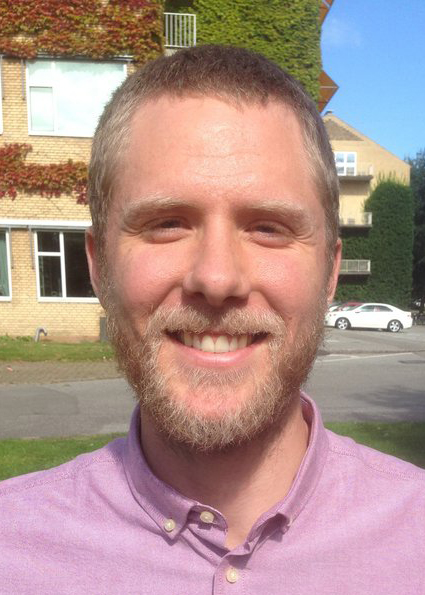Emil L. Kristoffersen: Detection of DNA modifying enzymes using DNA-based nanostructures – studying the silhouettes of enzyme reactions
PhD defence, Tuesday, 11 October 2016. Emil L. Kristoffersen

Imagine that you are sitting in a room tied to a chair. Behind you a puppet play is being performed. The only thing you can see is the shadows of the puppets cast on to the back-wall as dark contours. The play could be about Alexander the Great cutting the Gordian knot, who knows.
Using DNA-based sensors and DNA-based relay systems, Emil L. Kristoffersen has studied the fluorescence enlightened contours of enzymatic reactions, like they were shadows of puppets.
DNA-based sensors are DNA structures that emit signal upon enzymatic reaction and thus allow for real-time investigations of the enzymatic reaction. Such sensors have during Emil L. Kristoffersen’s work been applied to investigate the cancer relevant enzymes such as human Topoisomerase I and human Tyrosyl-DNA phosphodiesterase 1. The DNA-based sensors are useful agents for easy and quick enzyme reaction investigation. As demonstrated in Emil L. Kristoffersen’s PhD thesis, the DNA-based sensors were used in description of novel potential cancer drugs.
DNA-based relay systems are DNA structures that relay an enzymatic reaction in a way that can be specifically detected through downstream amplification techniques. During Emil L. Kristoffersen’s work the drastic reaction of the essential enzyme Topoisomerase II, cutting double-stranded DNA into pieces, has been detected by designing of a Gordian knot-like DNA nanostructure relay system consisting of interlinked DNA nano-circles. Fortunately, Topoisomerase II is – unlike Alexander - also able to reseal the double-stranded cuts, which upon reaction with the designed DNA nanostructure, result in decatenation and release of one intact DNA nano-circle. Emil L. Kristoffersen has worked with designing and developing of the DNA nanostructure as well as the method for detection of the decatenated DNA nano-circles. The method is based on Rolling Circle Amplification of the decatenated DNA nano-circle, thus allowing for down to single reaction sensitivity. Topoisomerase II is the target of multiple cancer drugs and has been suggested to be a potential cancer biomarker for chemo-response. Therefore, detection of Topoisomerase II enzyme activity by the developed method can potentially be used to improve chemotherapeutic treatment in the future.
Luckily, Emil L. Kristoffersen was not actually tied to a chair during his work, however, driven by his own enthusiasm the above presented scenario fits the essence of the studies performed during his time as a PhD student.
The PhD degree was completed at the Department of Molecular Biology and Genetics (MBG) and the Interdisciplinary Nanoscience Center (iNANO), Science and Technology, Aarhus University.
This résumé was prepared by the PhD student.
Time: Tuesday, 11 October 2016 at 11.00
Place: Building 1540, room K20, Department of Mathematics, Ny Munkegade 118, Aarhus University, 8000 Aarhus C.
Title of dissertation: A Study of Designed DNA Nanostructures and their use in Enzyme Activity Detection
Contact information: Emil L. Kristoffersen, e-mail: emilkrist@gmail.com, tel.: +45 2927 1306
Members of the assessment committee:
Professor Giovanni Capranico, PhD, Department of Pharmacy & BioTechnology, University of Bologna, Italy
Professor Brage Storstein Andresen, PhD, Department of Biochemistry and Molecular Biology, University of Southern Denmark
Associate professor Knud Erik Larsen (chair), Department of Molecular Biology and Genetics, Aarhus University
Main supervisor:
Associate Professor Birgitta R. Knudsen, Department of Molecular Biology and Genetics, Aarhus University
Co-supervisor:
Assisting Professor Megan Yi-Ping Ho, iNANO, Aarhus University
Language: The PhD dissertation will be defended in English
The defence is public.
The dissertation is available for reading at the Graduate School of Science and Technology/GSST, Ny Munkegade 120, building 1520, rooms 128-134, 8000 Aarhus C.
